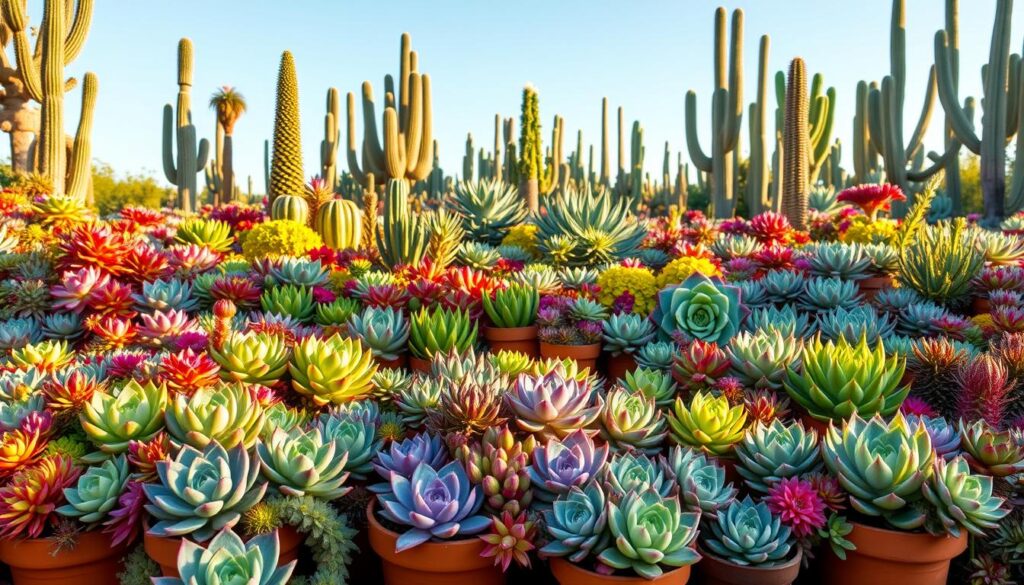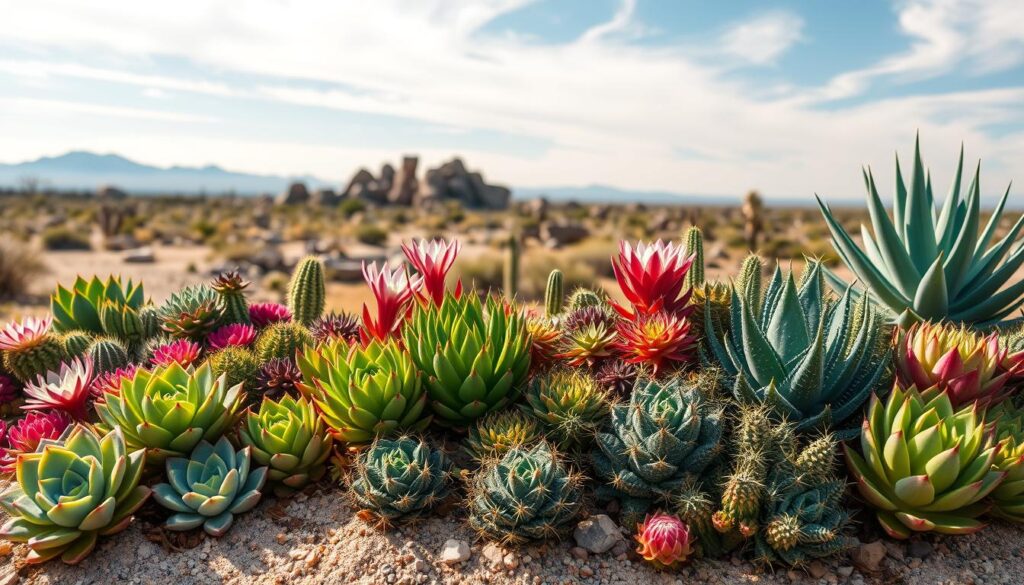Discover Top Succulent Types for Your Garden

About the Game
Succulents are favorites among many gardeners, both newbies and experts alike. They stand out with their unusual shapes and bright colors. Plus, they are easy to take care of. In this article, we’ll look at different types of succulents. We’ll talk about what makes each one special, how they can benefit your garden, and how to care for them. By the end, you’ll know which succulents will make your garden both beautiful and drought-resistant.
Introduction to Succulents
Succulents are unique because they store water in leaves, stems, and roots. This helps them live in dry places. They are loved for their ability to do well in sunny, dry spots. These plants vary widely in shape, size, and color. With over 2000 types, including favorites like Aloe and Echeveria, they offer much variety.
Many people enjoy succulent gardening for its beauty and ease. Since succulents keep water, they can go a long time without rain. This makes them perfect for drought-tolerant gardening. They add beauty and are easy to care for, making any outdoor area better.
Anúncios

Benefits of Adding Succulent Types to Your Garden
Adding succulents to your garden has many perks for both new and seasoned gardeners. A big plus is they don’t need much water. This is great for areas short on water or for busy people.
Anúncios
Succulents come in many colors and shapes. They can make any outdoor area look bright and special. They give your garden a distinct look unlike any other plants.
These plants are easy to care for. They grow well in poor soil and don’t need much fertilizer. This makes gardening easier for beginners and saves everyone time and effort.
Succulents also help clean the air inside your home. They make your living spaces healthier for your family. So, you can enjoy these plants inside and outside your home.
Popular Succulent Types for Garden Enthusiasts
Garden fans often look for different succulents to make their yards beautiful. Agaves, aloes, and echeverias are top picks. They not only make the garden look good but are easy to take care of in many gardens.
Agaves: Bold Statements in Your Landscape
Agaves catch the eye with their big, green leaves. These plants can get very big and like a lot of sun. Some agaves have different colors or stripes, making them stand out in your garden.
Aloe: Versatile and Medicinal
Aloes are praised for looking nice and being good for health. Aloe vera, for example, has a gel that’s good for the skin. They can get really tall and do well in both sun and part shade.
Echeveria: Colors and Variants
Echeveria is loved for its colorful, round leaves. They come in many colors, from light to bright. With more than 150 types, echeverias make gardens lively and beautiful. They even bloom, adding more charm.
Distinctive Features of Various Succulent Types
Learning about the special traits of popular succulents makes them more attractive for gardens and inside homes. The Crassula and Sempervivum types have unique features. These features are great for different settings.
Characteristics of Crassula and Jade Plants
The Crassula genus is famous for having many types, with the jade plant being very well-known. These plants have thick, shiny leaves with red or yellow edges. This makes them look beautiful. The jade plant has a strong build and can grow big or stay small, depending on how it’s cared for. It loves bright light, which helps it stay healthy and grow well. If given the right conditions, the jade plant may even bloom with small flower clusters.
Unique Attributes of Sempervivum
Sempervivum, also known as ‘hen and chicks,’ has over 3000 cultivars. These succulents grow into gorgeous rosettes with detailed leaf patterns, making them popular. They are very tough, doing well in cold places, and perfect for rock gardens. They don’t need much care and can handle tough conditions. These plants form tight groups of leaves, which can beautifully fill gaps in stones or line walkways.
Care Tips for Succulent Types
Succulents need special care to grow well. It’s important to follow tips to keep them vibrant and healthy. Focus on their water, soil, and light needs to help them thrive.
Watering Guidelines for Drought Tolerance
Getting watering right is key for succulents. Too much water causes root rot. Try to copy their dry natural homes. Let the soil dry completely before watering again.
Most succulents need water every 2-3 weeks. This depends on the weather and air moisture. This balance is crucial for their health and long life.
Soil and Light Requirements
Succulents need the right soil to grow. Use a mix that drains well, like a cactus blend. Adding sand to potting soil works well for them.
Most succulents love lots of sunlight. They do best with 6-8 hours of light a day. Yet, some can handle a bit less light. It’s best to check what each type needs.
Design Ideas for Incorporating Succulent Types
Succulents can make your garden look amazing. Think about succulent garden design with container gardens. They are great for changing seasons. Put big plants like Agave in the middle. Then, surround them with smaller ones like Echeveria and Sedum. This setup draws the eye.
Mixing different textures and colors adds depth to your garden. Small succulents are perfect for rock gardens or next to walkways. They make your garden both pretty and practical. Vertical gardens are a cool idea too. Use wall planters with hanging plants to save space.
Using succulents in your garden offers lots of design choices. They work well for a patio or a big garden. You can match them to your style and needs.
Creating a Drought-Resistant Garden with Succulents
A drought-resistant garden adds beauty and function to outdoors. Including succulents with plants like lavender and ornamental grasses creates a garden that saves water. Such gardens look good and help the environment by using less water.
Combining Succulents with Other Drought-Tolerant Plants
Choosing plants that need similar light and soil is key for a drought-resistant garden. Here’s how to make a successful design:
- Select low-water plants that complement succulents, ensuring a varied yet cohesive look.
- Incorporate native wildflowers to attract pollinators, adding life to the xeriscaped environment.
- Utilize mulch to retain soil moisture, which can help keep roots cool and support the overall health of the plants.
Conclusion
Succulents can make your garden look amazing and are easy to take care of. They look great and can grow well in many places. This makes them perfect for all gardeners. Their beauty and easy care make them a great choice for any outdoor area.
Knowing about different succulents is key to a great garden. When you know how to look after them, like how much water and light they need, you can make a beautiful garden with little work. This shows how tough plants can make an eye-catching and drought-proof garden.
Let succulents make your garden a peaceful spot. They come in many colors and shapes and don’t need much water. These plants will make your outdoor space calming and beautiful, adding a natural artistic touch.
FAQ
What are succulents?
How often should I water my succulents?
What type of soil is best for succulents?
Can succulents grow indoors?
Do succulents require fertilizer?
What are some popular succulent types for beginners?
How can I create a drought-resistant garden with succulents?
Can succulents purify the air?
What design ideas can I use for incorporating succulents?
Game Details
No
No